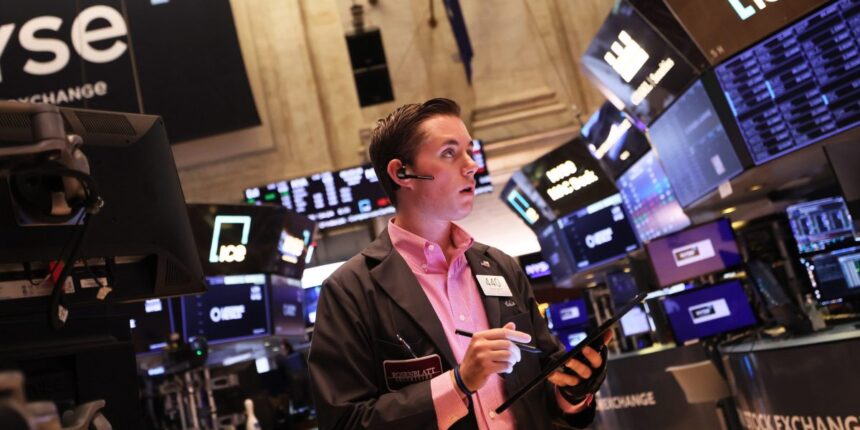
After more than a year of doomsday forecasts, a string of recent bullish economic data has led many of Wall Street’s top minds to push back or even retract their recession calls. Take Bank of America’s chief economist Michael Gapen, for example. The former Barclays exec began his tenure at Bank of America with a bold recession call last July, but has been forced to revise the timing of his forecast on multiple occasions over the past year. And in a Friday note to clients, Gapen admitted that recent data has also “surprised to the upside.” Still, he can’t shake that feeling he had.
Over the past few weeks, first quarter U.S. GDP growth was revised up to 2%; government data showed the U.S. economy added 209,000 jobs in June, pushing the unemployment rate down to 3.6%; and new data from the New York Federal Reserve revealed that the Federal Reserve Chair Jerome Powell’s favorite inflation gauge, the core personal consumption expenditures (PCE) index, may be overstating the true level of consumer price increases in the economy. The New York Fed’s new “multivariate core trend” inflation measure came in at just 3.5% in May, well below the 4.6% figure from the core PCE index.
Gapen wrote on Friday that he took a marketing visit to Asia last week and found the recent positive data had clients feeling “generally optimistic about the U.S. economy.” But they did have a few nagging questions, the chief of which was: “What could go wrong?”
To help outline the bear case, Gapen gave three reasons that he’s sticking to his guns and still believes a “mild recession” starting in the first half of 2024 is the logical “base case” for the U.S. economy despite recent optimism from some of his peers on Wall Street.
1. Tight credit and weak demand for loans
First and foremost, Gapen is worried about a credit crunch.
He noted that recent Senior Loan Officer Opinion Surveys (SLOOS) have shown that loan growth has “slowed significantly in most categories,” and loan officers nationwide expect that to continue through year-end. Banks have tightened their lending standards significantly since regional banks issues in March, which was headlined by the blowup of Silicon Valley Bank and Signature Bank, hoping to avoid falling into the same trap as their now fallen peers.
“We also see a risk that additional rate hikes will lead to another bout of regional bank stress, which would cause further credit tightening,” Gapen warned. “This should eventually weigh on investment, employment and spending.”
2. Student loan repayment aftershock
Gapen’s second major concern is the Supreme Court’s recent rejection of the Biden administration’s student loan debt relief plan. The White House announced a plan last August that would have canceled up to $10,000 in federal student loans for borrowers meeting certain income requirements, and $20,000 for borrowers who received Pell Grants, but the Supreme Court ruled last week that the Biden Administration doesn’t have the ability to forgive student loan debt without the approval of Congress. Now, repayments are set to resume in the late summer or early fall.
Gapen argued that the resumption of student debt repayments will have “knock-on effects to other categories of debt” including credit cards and auto loans, increasing delinquency rates over time, but most importantly, it will also reduce consumer spending, which makes up 70% of U.S. GDP.
“Given that lower-income consumers with higher marginal propensities to spend are most likely to be burdened by repayment, we think this could be a moderate headwind to growth,” he wrote.
Gapen isn’t alone in worrying about the effects that the resumption of student loans payments will have on consumers. “The expiration of the federal student loan repayment moratorium will further compound pressures on younger borrowers. As the interest burden on student debt rises, household payment capacity will be constrained, weakening household finances and consumer credits,”Moody’s Analytics analysts warned in their June “State of the U.S. Consumer” report.
3. The end of the line for the labor market
While the labor market has shown continued resilience in the face of aggressive interest rate hikes from the Federal Reserve since March of last year, Gapen fears the worst is yet to come for American workers.
The economist argued Friday that job gains have “outpaced” GDP growth over the last few quarters because businesses “have hoarded workers despite tepid demand” fearing they’ll face a repeat of the hiring issues that were so prevalent throughout the pandemic. This mix of increasing employment with fading GDP growth, along with recent job growth being dominated by the lower-wage service sector, has led to a drop in worker productivity. Nonfarm business sector labor productivity fell 2.1% in the first quarter, the Bureau of Labor Statistics reported June 1.
“That is probably not a sustainable dynamic,” Gapen explained. “Either GDP will accelerate to justify the hiring that has already happened, or payrolls will slow significantly and potentially decline. The latter is our base case and it would be accompanied by a much weaker economy.”
Gapen expects U.S. GDP to decline for two consecutive quarters at the start of 2024, but by just 1.5%, and argues the unemployment rate will rise to a peak of 4.7% next year.
“Although…the broader economy is growing around trend, we still think there are enough pockets of concern that a mild recession, starting in 1H 2024, should be the base case,” he concluded.
But Gapen might just be too bearish in general. His peers on Wall Street are pointing to the latest jobs report—which was healthy but cooler than expected—as evidence that a recession may not be inevitable after all. Morgan Stanley’s chief U.S. economist Ellen Zentner said in a Friday note that “the report today continues to point to a soft landing for the economy,” and Moody’s Analytics chief economist Mark Zandi tweeted that it was “close to perfect.” Is it time for the bears to go into hibernation?








